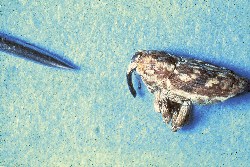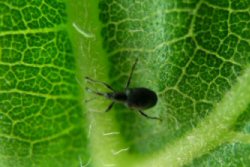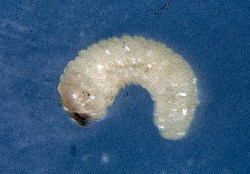Sunflower Stem Weevils

Figure 1

Figure 2

Figure 3
There are two main stem weevil species, the Spotted Sunflower Stem Weevil (Cylindrocopturus adspersus) and the black sunflower stem weevil (Apion occidentale).
Biology
The Spotted Stem Weevil adults (Figure 1) are about four to five millimetres (0.19 inches) long and grayish brown with varying shaped white spots on the elytron (wing covers) and thorax (area between head and abdomen). The snout, eyes and antennae are black. The larvae (Figure 3) are five to six mm (0.25 in.) long at maturity and creamy white with a small, brown head capsule. The larvae will normally be in a curled or C-shape position when found in sunflower stalk tissue. The spotted stem weevil adults emerge in mid to late June and feed on the epidermal tissue of the sunflower foliage and stem. This feeding does not affect plant vigor. Mating occurs soon after emergence of adults. Just prior to egg laying, females descend to the lower portion of the plant to deposit eggs individually in the epidermal tissue of the stem. Approximately 50 per cent of oviposition occurs by mid-July. Upon hatching in early July, the first instar (larval growth stage) larvae feed on subepidermal and vascular tissue. Feeding is concentrated in the pith tissue as the larvae develop to third and forth instars.
By the last week in August, the larvae have descended while feeding to just above the soil surface. A rudimentary chamber is constructed in the stem, and the weevils overwinter in this chamber as fifth instar larvae. Pupation of the overwintering larva occurs the following year in early June. There is one generation per year.
The Black Stem Weevil adults (Figure 2) are black and only 2.5 millimetres (0.09 inches) long from the tip of the snout to the tip of the abdomen. The snout is very narrow and protrudes forward from the head, which is small in relation to the rather large, almost globose body. The larvae are very similar in appearance to the spotted stem weevil except they are only 2.5 to three millimetres (0.09 - 0.12 inches) long at maturity and yellowish in color.
The black stem weevil overwinters as an adult in soil, plant residue, sod and weed clusters, and begins to emerge and feed on volunteer sunflower as soon as the plants reach the early seedling stage. Adult feeding on cultivated sunflower begins at the two- to four-leaf stage. Females deposit eggs under the epidermis of the stem. Larvae emerging from these eggs tunnel in the pith area of the stem, pupate and emerge as adults in early August.
Little or no Apion adult activity is observed for about two weeks in late July and early August. Apion adults emerging in August also feed on the leaves and stems of the plant, but as the plant matures and the leaves begin to die, the adults move under the bracts of the sunflower heads where they can be observed feeding until the plants are harvested.
Scouting Techniques
Look for stem weevils when scouting sunflower fields in late June and very early July. Sampling sites should be 23 to 31 metres (75 - 100 feet) in from the field margins. The field should be scouted in late June to very early July using the X pattern and examining five plants per stop for a total of 25 plants at the eight- to 14- leaf stage. The average number of weevils per plant can then be calculated.
NOTE: When surveying for stem weevils, the scout must move through the field slowly to avoid having the adult stem weevils drop to the soil and 'play dead' as they typically will do if care is not taken during survey and counting efforts. Adult feeding by both stem weevil species is considered to cause insignificant mechanical injury. However, since the Phoma macdonaldii Boerma organism has been isolated from the adults of both A. occidentale and C. adspersus, these two species are highly suspect in vectoring Phoma black stem disease in sunflower fields. A. occidentale has transmitted P. macdonaldii to sunflower as a result of their feeding activity under greenhouse conditions. Research is underway to determine whether or not this occurs in the field.
The only species of stem weevil larva that has been found to cause serious stalk breakage is the spotted stem weevil. When larval infestations of this species reach 25 to 30 or more per stalk, considerable weakening of stem tissue can result, especially when these larvae begin to create their overwintering cells in the base of the sunflower stalks. Breakage is most likely to occur when plants are under drought stress and/or during periods of high wind. The breakage typically occurs at or slightly above the soil surface in contrast to breakage attributed to stalk disease, which normally occurs farther up on the stalks.
Economic Thresholds
The economic threshold for the spotted sunflower stem weevil is one adult per three plants.
Control Tips
No insecticides are currently registered for control of sunflower stem weevils in Manitoba.
Delayed planting of sunflower until late May or early June has been effective in reducing densities of larvae in the stem. Fall tillage practices which either bury or break up sunflower stalks will help increase winter mortality of stem weevil larvae.
Natural enemies of the stem weevil include three species of larval parasitoids and one egg parasitoid. These wasps have accounted for approximately 30 percent mortality of the stem weevils in the past.
